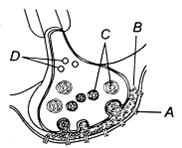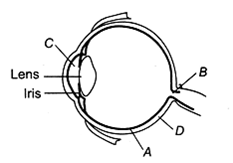 Short Answer Type
Short Answer Type Long Answer Type
Long Answer Type Multiple Choice Questions
Multiple Choice QuestionsPhotosensitive compound in human eye is made up of
opsin and Retinal
opsin ans Retinol
transducin and Retinene
transducin and Retinene
The most abundant intracellular cation is
Na+
Ca2+
H+
H+
D.
H+
Major intracellular cation is K+
Major extracellular cation is Na+
Ca+ play major role in signal transduction pathwayss.
H+ is found in aqueous solution of all acids.
A diagram showing axon terminal and synapse is given. Identify correctly at least two of A-D.

|
A – Receptor |
C – Synaptic vesicles |
|
B – Synaptic connection |
D- K+ |
|
A – Neurotransmitter |
B- Synaptic cleft |
|
A – Neurotransmitter |
B- Synaptic cleft |
Parts A, B, C and D of the human eyes are shown in the diagram. Select the option, which gives correct identification along with its functions/ characteristics
A - retina - contains photoreceptors -rods and cones
B-blind spot- has only a few rods and cones
C - aqueous chamber - reflects the light which does not pass through the lens
C - aqueous chamber - reflects the light which does not pass through the lens
Destruction of the anterior horn cells of the spinal cord would result in loss of
Sensory impulses
Voluntary motor impulses
Commissural impulses
Commissural impulses
In mammalian eye, the 'fovea' is the center of the visual field, where
high density of cones occur, but has no rods.
the optic nerve leaves the eye.
only rods are present
only rods are present
